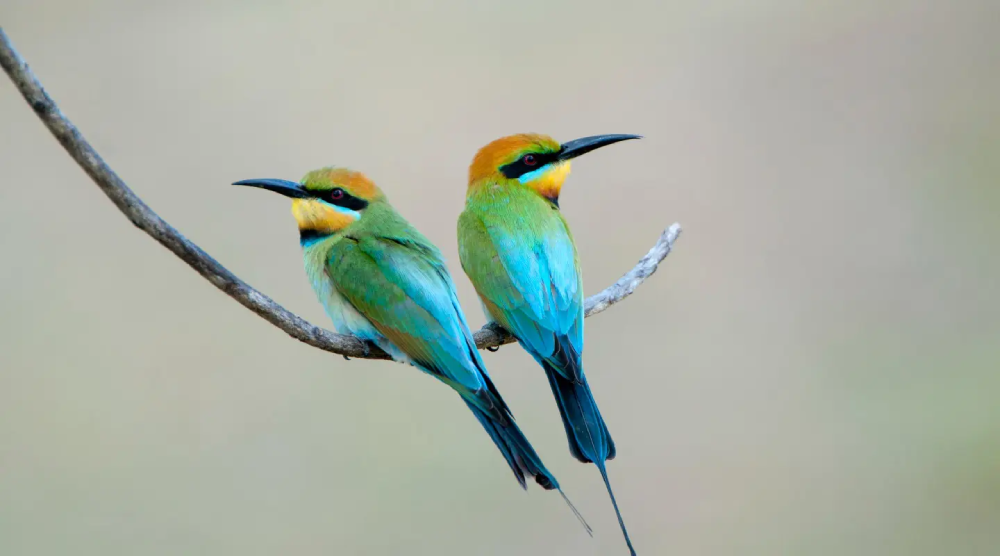Physical Characteristics
The Rainbow Bee-Eater is aptly named for its stunning coloration. This medium-sized bird, measuring about 19-24 centimeters in length, showcases an array of bright colors. Its plumage includes shades of green, blue, gold, and also orange. The head is crowned with a distinctive black mask, accentuating its red eyes. The throat is a vivid orange-yellow, contrasting with the emerald green of the back and wings. The tail feathers are elongated, with central feathers extending into distinctive streamers.
Habitat and Distribution
Rainbow Bee-Eaters inhabit a variety of environments, from open woodlands and savannas to riverbanks and coastal areas. They prefer areas with sandy or loamy soil, which are ideal for their nesting habits. These birds are commonly found across Australia, especially in the northern and eastern regions. They are migratory, with some populations moving to Indonesia, Papua New Guinea, and occasionally the Solomon Islands during the Australian winter.
Diet and Feeding Habits
As their name suggests, bee-eaters primarily feed on bees and other flying insects. Their diet includes wasps, dragonflies, beetles, and moths. They are expert hunters, capturing their prey mid-flight with incredible precision. Once caught, the bee-eater returns to a perch and skillfully removes the sting and venom by repeatedly hitting the insect against the perch. This ensures the insect is safe to eat and devoid of harmful toxins.
Breeding and Nesting
Rainbow Bee-Eaters have a unique approach to nesting. During the breeding season, which typically occurs from August to January, these birds dig long tunnels into sandy banks or flat ground. The tunnels can extend up to a meter in length and terminate in a nesting chamber. Both male and female participate in excavating the nest.
Females lay a clutch of about 3-7 white eggs, which are incubated by both parents. The incubation period lasts around 24 days. Once hatched, the chicks are altricial, meaning they are born naked and blind, relying entirely on their parents for warmth and food. The parents, along with occasionally helpers (usually older offspring from previous broods), feed the chicks a steady diet of insects until they fledge at about 30 days old.

Behavior and Social Structure
Rainbow Bee-Eaters are highly social birds, often seen in small flocks outside the breeding season. They are known for their communal roosting habits, also gathering in large numbers in trees at night. Their social structure is quite complex, involving cooperative breeding where helper birds assist in raising the young.
During the day, these birds engage in spectacular aerial displays. They are agile fliers, performing acrobatic maneuvers to catch insects on the wing. Their calls, a series of melodious, rolling “prrp” sounds, can be heard as they communicate with each other during flight.
Migration Patterns
The migration patterns of Rainbow Bee-Eaters are influenced by seasonal changes and food availability. In Australia, northern populations tend to be resident or move short distances, while southern populations undertake longer migrations. During the winter months, many birds migrate northward to warmer regions in Indonesia and Papua New Guinea. They return to Australia in the spring to breed.
Conservation Status
Currently, the Rainbow Bee-Eater is classified as a species of least concern by the International Union for Conservation of Nature (IUCN). Their wide distribution and large population size contribute to this status. However, habitat destruction and pesticide use pose potential threats to their populations. Conservation efforts focus on preserving their natural habitats and promoting sustainable agricultural practices to ensure the availability of their insect prey.
Cultural Significance
The Rainbow Bee-Eater holds a special place in various cultures, particularly among Indigenous Australian communities. These birds are often featured in Aboriginal art and mythology, symbolizing beauty, agility, and the vibrant colors of nature. Their presence is celebrated in folklore and storytelling, highlighting their importance in the cultural heritage of the regions they inhabit.
Conclusion
The Rainbow Bee-Eater is a remarkable bird that captivates with its vivid colors, intricate behaviors, and graceful flight. Its role in controlling insect populations and its presence in diverse ecosystems underscore its ecological importance. So, as we continue to study and admire these stunning birds, it is crucial to ensure their habitats are protected, allowing future generations to witness the splendor of the Rainbow Bee-Eater in the wild.









